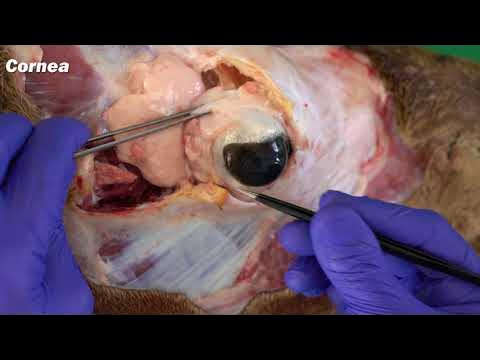Virtual Jellyfish Dissection
Summary
TLDRThis video dissects the anatomy of the Aurelia, or Moon Jellyfish, highlighting its unique biradial symmetry and key structures. It explains the jellyfish's radial body shape, oral arms, and manubrium that connects them to the mouth. The video covers the role of nidocytes in stinging, the gastrovascular cavity for digestion and gas exchange, and the gonads responsible for reproduction. It also delves into the ropalium, a simple nervous structure that helps the jellyfish orient itself and sense light. The video provides a comprehensive overview of the jellyfish’s internal and external features, explaining how they contribute to its survival.
Takeaways
- 😀 The moon jellyfish (Aurelia aurita) exhibits biradial symmetry, which means it can be bisected multiple ways along its oral-to-aboral axis.
- 😀 The jellyfish's body has two distinct surfaces: the subumbrella (lower) and the exumbrella (upper), with the exumbrella seen in popular media like *Finding Nemo*.
- 😀 The jellyfish has four oral arms that surround the mouth, helping in food gathering and digestion.
- 😀 The oral arms are connected to the body by a structure called the manubrium, a stalk-like feature.
- 😀 Nematocysts (stinging cells) are located along the tentacles, not the oral arms, and are responsible for stinging prey.
- 😀 The mouth of the jellyfish is located on the oral surface, and it has a cross-shaped appearance when examined.
- 😀 The gastrovascular cavity is crucial for digestion, gas exchange, waste elimination, and gamete release.
- 😀 Radial canals send nutrients from the gastrovascular cavity to the ring canal, which circles the umbrella of the jellyfish.
- 😀 Jellyfish have two pairs of gonads, which are important for reproduction, but gender identification requires a tissue sample.
- 😀 The ropalium is a small but vital nervous structure that helps the jellyfish sense light and orientation, aiding its balance and environmental interaction.
- 😀 Statocysts within the ropalium help the jellyfish stay oriented right-side-up and sense its environment.
Q & A
What is the symmetry of the Aurelia (moon) jellyfish?
-The Aurelia jellyfish exhibits biradial symmetry, meaning it has a circular shape and can be bisected in multiple ways along its oral-to-aboral axis. It has two pairs of gonads and two pairs of oral arms.
What are oral arms, and what is their function?
-Oral arms are four extensions surrounding the jellyfish's mouth. They help gather food and bring it into the mouth, playing a crucial role in the jellyfish's feeding process.
What is the role of the manubrium in the jellyfish's anatomy?
-The manubrium is a stalk-like structure that attaches the oral arms to the body. It surrounds the mouth and helps in connecting the oral arms to the gastrovascular cavity.
What are nidocytes, and where are they located on the moon jellyfish?
-Nidocytes are specialized stinging cells found along the margin of the umbrella. These cells discharge when the jellyfish stings its prey, releasing toxins.
Where are the tentacles of the jellyfish located, and what is their function?
-The tentacles are located along the margin of the jellyfish's body. They contain several nidocytes and are responsible for stinging and capturing prey.
What is the gastrovascular cavity, and what are its functions?
-The gastrovascular cavity is the central digestive space in the jellyfish's body, lined by gastrodermis. It plays a role in digestion, gas exchange, and the release of metabolic waste and gametes.
How do nutrients move through the moon jellyfish's body?
-Nutrients are moved through the jellyfish via radial canals, which direct them to the ring canal, a thick tissue along the margin of the umbrella.
What are gonads, and how do they function in the jellyfish?
-Gonads are reproductive organs found within the jellyfish's body. The moon jellyfish has four gonads (two pairs), which release sperm or eggs into the gastrovascular cavity, where they exit through the mouth.
What are rhopalia, and what role do they play in the jellyfish's nervous system?
-Rhopalia are structures located around the jellyfish's body that contain part of the nervous system. They help the jellyfish sense its environment, detect light and dark, and maintain orientation using statocysts.
How does the jellyfish determine its orientation, such as right side up versus upside down?
-The jellyfish uses statocysts, which are found in the rhopalia, to detect its orientation. These structures help the jellyfish maintain balance and determine which way is up.
Outlines

This section is available to paid users only. Please upgrade to access this part.
Upgrade NowMindmap

This section is available to paid users only. Please upgrade to access this part.
Upgrade NowKeywords

This section is available to paid users only. Please upgrade to access this part.
Upgrade NowHighlights

This section is available to paid users only. Please upgrade to access this part.
Upgrade NowTranscripts

This section is available to paid users only. Please upgrade to access this part.
Upgrade NowBrowse More Related Video

Phylum Cnidaria | Animal kingdom | Biology | Khan Academy

Anatomy Series, Male Urethra, Vas Deferens and Ejaculatory Duct by Dr. Shakti Chandra

lophophorates

Nerves of nasal cavity (preview) - Human Anatomy | Kenhub

Anatomy of the Eye, Eye muscles and associated structures

Why is Plant ID important? An example of using a Dichotomous Key.
5.0 / 5 (0 votes)